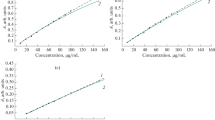Summary
-
1.
A rapid and reliable method is described for assaying reduced ascorbic acid in some fresh fruits and green leafy vegetables that give dark coloured extracts which make the direct visual titration with indophenol impracticable.
-
2.
The pink end-point colour of the titration (otherwise masked by the dark colour of sample-extract) is extracted with ether to form a distinct pink upper layer when the end-point is reached.
-
3.
The end-point can be easily discerned visually.
-
4.
Heavy solvents make the operation lengthy owing to formation of emulsions, but lighter solvents, especially ethyl ether, do not suffer from this disadvantage.
-
5.
The new technique is especially suitable for outdoor work and when almost simultaneous analysis is needed of certain other constituents of the material in thefresh state.
-
6.
The excess of reagent needed to yield the end-point colour is very small, and the end-point is therefore accurate.
Zusammenfassung
Eine schnelle Methode zur Bestimmung reduzierter Ascorbinsäure in frischen Früchten und grünen Blattgemüsen, die stark gefärbte Extrakte liefern und daher für die direkte Titration mit Indophenol ungeeignet sind, wird beschrieben. Die rosa Farbe des Titrationsendpunktes (die sonst von der starken Farbe des Extraktes verdeckt ist) wird mit Äther extrahiert, so daß man den Endpunkt in der deutlich rosa gefärbten ätherischen Schicht wahrnehmen kann. Spezifisch schwere Lösungsmittel führen leicht zu Emulsion, während spezifisch leichte Lösungsmittel, besonders Äther, diesen Nachteil nicht haben.
Das neue Verfahren ist besonders für Feldanalysen geeignet und außerdem dann, wenn gleichzeitig andere Bestandteile imfrischen Untersuchungsmaterial bestimmt werden sollen.
Der zum Farbumschlag nötige Reagensüberschuß ist sehr klein, der Endpunkt daher scharf.
Résumé
On décrit une méthode rapide et exacte pour doser l'acide ascorbique réduit dans des fruits frais et dans des légumes verts à feuilles, qui donnent des extraits colorés en noir rendant impossible le titrage visuel direct par l'indophénol. On extrait par l'éther le produit de couleur rose au point équivalent du titrage (masquée autrement par la coloration noire de l'extrait de l'échantillon) pour former une couche distincte rose, qui surnage, quand le point équivalent est atteint. Celui-ci se distingue facilement à l'oeil. Les solvants lourds rendent l'opération assez longue en raison de la formation d'émulsions mais les solvants légers, spécialement l'éther, ne présentent pas cet inconvénient. La nouvelle technique convient spécialement pour le travail à l'extérieur et lorsqu'on a besoin d'une analyse presque simultanée d'autres constituants de la substance à l'étatfrais. L'excès de réactif nécessaire pour donner la coloration du point équivalent est très faible et celui-ci est par conséquent précis.
Similar content being viewed by others
References
O. A. Bessey, J. Biol. Chem.126, 771 (1938).
F. Bukatsch, Z. physiol. Chem.262, 20 (1939).
Folkmann, Referred to in “The Analysis of Foods”, by Winton and Winton, 2nd Printing. New York: Wiley. 1947.
L. J. Harris, L. W. Mapson, andY. L. Wang, Biochem. J.36, 155 (1942).
L. P. Pepkowitz, J. Biol. Chem.151, 405 (1943).
J. H. Roe andC. A. Kuether, J. Biol. Chem.147, 399 (1943).
J. H. Roe andM. J. Oesterling, J. Biol. Chem.152, 511 (1944).
J. Tillmans, Z. Untersuch. Lebensmitt.60, 34 (1930).
A. Emerie, Biochem. J.28, 269 (1934).
A. Emerie andVan Eekelen, Biochem. J.28, 1153 (1934).
E. W. McHenry andM. Graham, Biochem. J.29, 2013 (1935).
L. J. Harris andM. Olivier, Biochem. J.36, 155 (1942).
J. D. Pouting, Ind. Eng. Chem., Analyt. Ed.15, 389 (1943).
Vit. Chemists, “Methods of Vitamin Assay”, by Association of Vitamin Chemists, 2nd Ed. New York: Interscience. 1951.
U. S. Pharmacopeia, XVth edition.
J. W. H. Lugg, Nature150, 577 (1942).
L. W. Mapson, Nature152, 13 (1943).
W. B. Robinson andE. Stotz, J. Biol. Chem.160, 217 (1945).
L. W. Mapson, J. Soc. Chem. Ind.62, 223 (1943).
H. R. Rosenberg, Chemistry and Physiology of Vitamins. New York: Interscience. 1945.
Author information
Authors and Affiliations
Additional information
This work was carried out in India on the Indian Council of Medical Research enquiry, “Studies on Nutritive Value of foodstuffs in North-west region of India” and has been included in the enquiry's annual report submitted to the Council in October 1960.
Rights and permissions
About this article
Cite this article
Nadkarni, B.Y. Determination of ascorbic acid in coloured extracts: A new modification of the indophenol technique. Mikrochim Acta 53, 21–27 (1965). https://doi.org/10.1007/BF01218730
Received:
Issue Date:
DOI: https://doi.org/10.1007/BF01218730




